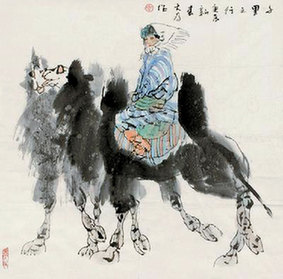 THE market for Chinese art is expanding rapidly. Unlike the Japanese, who helped drive up the price o@f modern oil paintings in the 1980s, Chinese favor homegrown traditional Chinese paintings. The passion of collectors, however, has not been passed on to art students.
THE market for Chinese art is expanding rapidly. Unlike the Japanese, who helped drive up the price o@f modern oil paintings in the 1980s, Chinese favor homegrown traditional Chinese paintings. The passion of collectors, however, has not been passed on to art students.
The nouveau riche are keen to buy Chinese paintings, either for their own collections or as gifts for friends and relatives. Museums around the world are also interested, with a general interest in China growing. In 2005 alone, revenue from Chinese paintings was 20 billion yuan (then about US$243m).
A recent survey by the Artron art market department revealed that traditional Chinese paintings of the 20th century and by ancient masters were the most sought after, with 52 percent of buyers preferring ancient works and 32 percent seeking contemporary Chinese art. It was also noted that the most expensive contemporary Chinese paintings sell for more than 2 million yuan (US$290,000).
Despite the growing market, students are shunning programs teaching traditional art. Applied arts programs such as architecture and design are the most popular in Chinese universities. Compared with other fine arts programs — oil painting, print and sculpture — traditional Chinese painting attracts the least number of students.
Qiu Ruimin, dean of the College of Fine Arts at Shanghai University, said the Chinese Painting Department at his college offered an extra round of enrolments before general recruitment. The opportunity, however, was always bypassed. There were years when applicants did not fill the seats in the recruitment plan. In other universities, Chinese painting departments had either been dropped or were struggling on the verge of extinction.
Vice chairman of the Shanghai Artists Association, Zhang Peicheng, said many students applied for art majors but not of their own will. “They do not have a passion for art. They just have no better choice.” Take the example of Jiangxi Province: The National College Entrance Exams score requirement for an art major is only 60 percent of that required for other majors at general colleges. For art majors, Chinese painting was the last choice after design, oil painting and others. The arts exam score required for architecture majors in Shanghai University this year was 87.2 points, followed by art design at 86.2 points, then followed by Chinese painting at 80.7 points.
Why don’t young people like Chinese painting? For students growing up in the 1990s, many think Chinese paintings are “out.” Most students, who have no choice but to learn Chinese painting, had never touched a brush before enrolling in the department.
A professor surnamed Wang from the Guangzhou Fine Arts Academy said the education of traditional Chinese painting had been missing in primary and middle schools. As a result, students had no idea of what to expect. “We never think of applying for the Chinese painting major, because we know nothing about it,” said Wu Xiaofeng, a design major at Shenzhen Polytechnic.
Chinese painting has lost its significance in art circles in contemporary China. Many insiders called for reform in recruiting fine arts students during a conference at the Shanghai University of Communications last month.
“All students of fine arts are required to take exams in sketching, drawings and color paintings, which all fall within the realm of Western fine arts,” a Chinese painter told the conference. “Their potential and abilities in traditional Chinese painting are not evaluated. As a result, many start from the very beginning. It’s difficult for the students and the teachers.”
Wu agreed. “We all want to learn something we’ve already passed at the ABC stage,” she said. “How exhausting it would be if I had to start all over again in university.”
She said her classmates preferred design because it was easier to find a job. “I don’t picture myself making a living painting portraits for passers-by on the street. And I am not that confident I could exhibit my works in a gallery. So it’s more secure to choose design.”
With the Internet helping to spread various cultural and art forms from country to country, traditional Chinese paintings quickly lose luster for students chasing new and exciting careers.
People need a traditional Chinese cultural disposition to learn and appreciate Chinese painting. The art has been nudged out by Western and new media arts since the 20th century. In a bigger arena and judged from different perspectives, Chinese painters have been struggling to reform and enrich the art. They have introduced bold colors and other touches to add visual impact, which has also left them open to harsh criticism.
The bigger concern is: When fewer and fewer young people care, what is the future for traditional Chinese painting? It’s time to rebuild the connection and encourage young people to continue this traditional art form.
(Li Dan)
|

